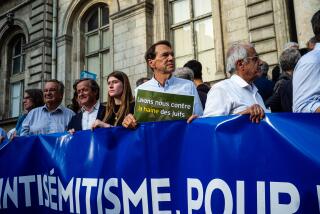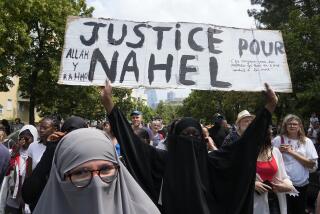Stately Lyon, Its Barbie Trial Fears Gone, Can Again Focus on Beauty, Fine Cuisine
- Share via
LYON, France — For centuries, Lyon, a stately city on the banks of two rivers, competed with Paris for control of the French economy. But those days are long gone.
Lyon is still a wealthy city, with a population of 1.2 million. But it is now regarded as, at best, a distant second to Paris, far from being a rival in any endeavor except gastronomy. Except to praise its restaurants, most French and most foreigners pay scant attention to Lyon. They take notice only when something special happens, like the trial of Klaus Barbie, the former Gestapo chief here.
The trial, which ended early Saturday with Barbie being sentenced to life imprisonment for “crimes against humanity,” has focused new attention on the history and beauty of this Renaissance city on the Saone and Rhone rivers. The attention, however, has confused many Lyon residents, for it has been both better and worse than they expected.
“Everyone was worried about the trial four years ago,” acting Mayor Andre Soulier told an interviewer, “but our fears disappeared.”
Uneasiness Apparent
When Barbie, now 73, was brought back to Lyon in 1983 after his expulsion from Bolivia, many Lyonnais did not hide their uneasiness.
“Right now,” Albert Decourtray, the Roman Catholic archbishop of Lyon, said in an interview in 1983, “I have more fears about the case than hopes.”
The fears were simple. Lyon had long been known as “the capital of Resistance” during World War II. Lyon was the center of much of the fighting against the German occupation and the collaborationist Vichy government of Marshal Philippe Petain. It was no accident that Jean Moulin, the agent sent by Gen. Charles de Gaulle to unite the Resistance, was captured by Barbie in Lyon.
But it was less known, or at least less talked about, that Lyon was also “the capital of collaboration” during World War II. Many leading Lyonnais actively supported Petain and earned a good deal of money supplying goods to the occupation troops. Some people here feared that a trial exposing this collaboration might tear the city apart.
A Socialist Move
“Do not forget that it was a Socialist government that brought Barbie back to France,” said Yves Leridon, the Lyon correspondent of the Paris newspaper Le Figaro. “Many Lyonnais thought that a trial would be used by the Socialists to help break the power of the bourgeoisie of Lyon.”
These fears dissipated when the conservative government of Premier Jacques Chirac, elected in 1986, decided to go ahead with the trial and it became obvious that the trial would focus not on collaboration but mainly on the Nazi campaign to exterminate the Jews. The most telling charge against Barbie was the arrest and deportation to Auschwitz of 44 children from a camp in the village of Izieu.
Officials Overzealous
After the early hesitation, in fact, city officials decided that the trial would help Lyon by attracting journalists from all over the world. The officials may have been overzealous, preparing elaborate press kits stuffed with gastronomic guides and wrist watches advertising Lyon. The kits seemed more suitable for an American political convention than the French murder trial of a Nazi, and the officials smarted under a hail of criticism.
To make matters worse for Lyon, most foreign journalists left the city in the first week of the trial, when Barbie announced his refusal to attend any more sessions.
“City officials were astounded and upset,” Leridon said. Their main catch had escaped the net.
During the trial, there were long lines of Lyonnais, even on hot days, waiting to be admitted to an area of the courtroom that has room only for 50, and all had to stand. Most of them were young people in their teens and 20s.
Resentment of Young
“Most people over the age of 40 did not care about the trial,” Leridon said over lunch in an outdoor restaurant in the old part of town near the courthouse. “They said it was old news. But the young people are asking questions now about why this was all hidden from them. I myself am 55 years old, and I never heard about the children of Izieu until the proceedings began.
“I think the resentment of young voters is going to hurt older politicians in Lyon, and it is going to hurt the politicians of all parties.”
Lyon still bears the marks of World War II in such buildings as the Hotel Terminus, which the Gestapo used as its headquarters. But the city is marked mainly by two other, far different, historical periods: the late Medieval Era, when it was the economic power of France, and the 18th and 19th centuries, when it attracted worldwide attention for its silk and its banks and stock exchange.
Lyon’s power in the 16th Century came from Italian merchants, who used it as a banking center and as a fair to market their wares. As a result, old Lyon, on the west bank of the Saone, where the Barbie trial took place, is reputed to have the greatest concentration of Renaissance architecture in France. The city encourages this atmosphere by asking landlords throughout Lyon to paint their buildings only in Renaissance pastels, such as rose and beige.
Downtown Gray, Stately
The downtown center of Lyon, on the peninsula between the Saone and Rhone rivers, is more gray and stately than old Lyon. But it too reflects past glory, for although Lyon still produces quality silk, it long ago lost its leadership in textile production to Asia. And although it is still a regional capital of finance, it long ago lost its financial leadership in France to Paris.
Rivalry with Paris still exists but without the fury of the past. After the French Revolution, for example, Lyon’s opposition to the revolutionary government prompted the National Convention in Paris to issue a proclamation in 1793 calling for the destruction of the city.
Once Lyon was destroyed, the proclamation said, a column would be erected on the ruins of the city with the inscription: “Lyon fought against liberty. Lyon is no more.”
Although the revolutionary army did tear down some buildings in the Place Bellecour, the city itself was never destroyed.
Proud of Opposition
“The Lyonnais are still proud of what happened,” said Michel de Saint-Etienne, a City Hall press officer.
Their pride comes not from their opposition to the revolution but from their opposition to Paris.
A few years ago, when high-speed trains--the TGVs--cut the travel time from Paris to Lyon to two hours, some city officials feared an exodus of Lyon businessmen to Paris, a galling prospect. They would live in Paris but commute to work in Lyon. City officials say this has not happened.
Although Lyon still lives for the most part in the shadow of Paris, Archbishop Decourtray, who is now a cardinal, still keeps the historical title of Primate of all the Gauls and is probably the most influential church leader in France.
Advocate of Jewish Causes
“But that does not come from being primate,” Leridon said. “That is no more than an honorary title. It comes from the force of his personality.”
Perhaps because of his experience with the anguish of the Barbie trial, Decourtray has become one of the church’s main advocates of Jewish causes. He took the lead in helping to persuade the Polish Roman Catholic Church to remove a convent from the grounds of the Auschwitz extermination camp this year. And he recently issued a statement expressing his bewilderment when Pope John Paul II officially received President Kurt Waldheim of Austria despite accusations that Waldheim had been involved with German Army units responsible for the deportation of Jews during World War II.
Decourtray’s close ties with the leaders of the 35,000 Jews in the Lyon metropolitan area are far different from Jewish-Catholic relations during the war.
In a recent article, Marc Riboud, a famous French photographer, described the city’s deep anti-Semitism when he grew up there in the 1930s. He said that “Lyon anti-Semitism provided a favorable terrain for Nazi repression.” That has disappeared, but some Lyonnais insist that the society of their city is still closed to what it regards as outsiders--from assimilated Jews to the relatively new and poor North African immigrants living in the suburbs.
Major Attraction
Gastronomy is probably Lyon’s most important tourist attraction, and there are stories of visitors taking the TGV from Paris at 10 a.m., lunching at Paul Bocuse’s Restaurant just north of Lyon and catching the 4 p.m. train back to Paris.
Many gourmets believe that Lyon has the greatest concentration of good restaurants in France. The Gault Millau guide gives 15 Lyon-area restaurants 15 points or better out of a possible 20. The best-known restaurateur is surely Bocuse, who has become a star of French cooking.
Bocuse, who is more of a personage now than a chef, no longer does the cooking at his restaurant but goes from table to table autographing cookbooks and menus and posing for pictures with clients. But despite the hype, his restaurant does provide some of the finest meals in France. It is given 19 points.
City officials are trying hard to make Lyon known for more than its food and its past. It has become a center for biotechnology, computer and other high-technology industries.
‘International City’
Lyonnais are campaigning hard to convince others in southern France, in northern Spain, northern Italy and Switzerland that the city could become a natural geographic center for them when the European Economic Community breaks down all trade barriers and becomes a true common market. This is scheduled for 1992.
The slogan, printed on many brochures found in the Barbie trial press kit, is “Lyon, International City.” In a limited way, the slogan recalls the grandeur of the past.
More to Read
Sign up for Essential California
The most important California stories and recommendations in your inbox every morning.
You may occasionally receive promotional content from the Los Angeles Times.













